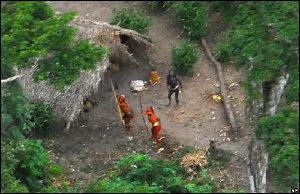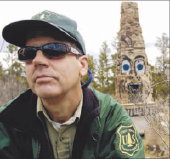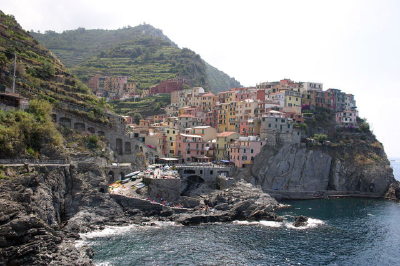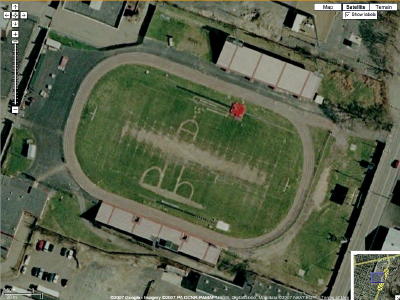Algeria’s River of Ink —
The Proceedings of the Athanasius Kircher Society has posted
an interesting geographical puzzle. An article, "The Story of Ink," in the 1930 issue of the
American Journal of Pharmacy included the following statement:
Iron tannin inks are sometimes formed naturally; such a phenomenon has been observed in Algeria, a country in northern Africa, where there exists a "river of ink." Chemical examinations of the waters of the streams combining to form this river revealed that one of the streams is impregnated with iron from the soil through which it flows while the other stream carries tannin from a peat swamp. When the two streams joined, the chemical action between the tannic acid, the iron and the oxygen of the water caused the information of the black ferric tannate, making a natural river of ink.
Does this river of ink actually exist? And if so, where is it on a map?
The earliest reference to this mysterious river I could find occurred in
The Athens Messenger on May 25, 1876. The short blurb read:
"A river of ink has been discovered in Algeria. Let them find a mountain of paper, and then send for William Allen."
For the next seven decades, similar passages -- almost verbatim to what ran in the Am. Jour. of Pharmacy -- appeared regularly in newspapers. They were typically thrown in as an odd bit of trivia to fill up column space. However, the name and location of the river itself (except for the fact that it was in Algeria) was never identified.
More recently, Bruce Felton and Mark Fowler included a passage about this river in their 1994 book
The Best, Worst, & Most Unusual: Noteworthy Achievements, Events, Feats & Blunders of Every Conceivable Kind:
Most Unusual River: The comingling of two tributary streams in Algeria forms a river of ink: One brook contains iron; the other, which drains from a peat swamp, contains gallic acid. Swirled together, the chemicals unite to form a true black ink. (Black Brook in upstate New York is formed by a similar chemical blend.)
Though the chemical composition of this "river of ink" sounds plausible, the other details about it are so vague that it sounds a bit like a geographical urban legend.

 The Brazilian government released some dramatic pictures of one of South America's last remaining uncontacted indigenous tribes. It says it took the pictures to prove that the tribe existed, because there apparently were some people who doubted this.
The Brazilian government released some dramatic pictures of one of South America's last remaining uncontacted indigenous tribes. It says it took the pictures to prove that the tribe existed, because there apparently were some people who doubted this. The image to the right is available for purchase on webshots.com. The photographer is listed as Adam Jones. It's titled "Grand Teton and Wildflowers, Wyoming."
The image to the right is available for purchase on webshots.com. The photographer is listed as Adam Jones. It's titled "Grand Teton and Wildflowers, Wyoming." A chimney is all that remains of the cabin that used to be the home of the manager of the Forest Service tree nursery in Pike Forest. It's considered a historically significant remain. That didn't stop pranksters from refashioning it, with the help of some paint, into a monument to SpongeBob Squarepants. From gazette.com:
A chimney is all that remains of the cabin that used to be the home of the manager of the Forest Service tree nursery in Pike Forest. It's considered a historically significant remain. That didn't stop pranksters from refashioning it, with the help of some paint, into a monument to SpongeBob Squarepants. From gazette.com:

 Pictures have been circulating showing an expanded observation deck that is supposedly going to be added to the Eiffel Tower, transforming it into something resembling a giant mushroom. An article in the Guardian stated:
Pictures have been circulating showing an expanded observation deck that is supposedly going to be added to the Eiffel Tower, transforming it into something resembling a giant mushroom. An article in the Guardian stated: A few weeks ago a story was going around about a street in London where the lampposts had been padded in order to protect text-messaging pedestrians. Neo posted about it in the forum. The story sounded pretty ridiculous, and sure enough it turns out to have been a publicity-stunt hoax. The padding was placed on the lampposts by a pr firm, and it was only there for a day and a half. The Press Gazette reports:
A few weeks ago a story was going around about a street in London where the lampposts had been padded in order to protect text-messaging pedestrians. Neo posted about it in the forum. The story sounded pretty ridiculous, and sure enough it turns out to have been a publicity-stunt hoax. The padding was placed on the lampposts by a pr firm, and it was only there for a day and a half. The Press Gazette reports: In 2006 I posted about the road of non-starting cars in the town of Gosport, England. An unknown force on this road was preventing cars from starting. I don't know if Gosport ever solved its problem, but it seems that the neighborhood around the Empire State Building in New York City is experiencing the same issue.
In 2006 I posted about the road of non-starting cars in the town of Gosport, England. An unknown force on this road was preventing cars from starting. I don't know if Gosport ever solved its problem, but it seems that the neighborhood around the Empire State Building in New York City is experiencing the same issue. The Unrecognised States Numismatic Society (USNS) describes itself as a "group catering to numismatists whose collecting interests largely focus on coins minted by groups purporting, pretending or appearing to be sovereign states, but which are not recognised as such by established governments."
The Unrecognised States Numismatic Society (USNS) describes itself as a "group catering to numismatists whose collecting interests largely focus on coins minted by groups purporting, pretending or appearing to be sovereign states, but which are not recognised as such by established governments."
 The website for Porthemmet Beach advertises that it is the best beach in Cornwall. It also claims that it's the only beach in the UK to allow topless sunbathing. So how does one find this beach? These are the directions on the website:
The website for Porthemmet Beach advertises that it is the best beach in Cornwall. It also claims that it's the only beach in the UK to allow topless sunbathing. So how does one find this beach? These are the directions on the website: On Flickr someone with the screenname "melastmohican" has uploaded a picture of a "moving rock" located in the Racetrack Playa region of Death Valley, California. The caption reads:
On Flickr someone with the screenname "melastmohican" has uploaded a picture of a "moving rock" located in the Racetrack Playa region of Death Valley, California. The caption reads:  Kevin Keeble stirred up a lot of excitement when he sent pictures to the Newquay Guardian showing a great white shark that he claimed to have spotted about a mile off the coast of Cornwall. At the time he said, "We were out about one mile off Towan Head and I saw this fin in the distance. We were reeling in the mackerel but I picked up my camera and caught a picture with my telephoto lens. The shark was about 100ft away. It was only there for a few seconds before it disappeared."
Kevin Keeble stirred up a lot of excitement when he sent pictures to the Newquay Guardian showing a great white shark that he claimed to have spotted about a mile off the coast of Cornwall. At the time he said, "We were out about one mile off Towan Head and I saw this fin in the distance. We were reeling in the mackerel but I picked up my camera and caught a picture with my telephoto lens. The shark was about 100ft away. It was only there for a few seconds before it disappeared."  A 180ft image of a donut-waving Homer Simpson recently appeared on a hillside in Dorchester, beside the famous Cerne Abbas Giant. The image is part of the publicity for the new Simpsons movie. However, the stunt has not pleased local pagans, who believe it to be disrespectful. Catherine Hosen, Wiltshire representative for The Pagan Federation, says, "I find it quite shocking and very disrespectful. It's just a publicity stunt for a film and we are talking about a monument which is definitely of great historical significance and a lot of people feel has important spiritual significance as well."
A 180ft image of a donut-waving Homer Simpson recently appeared on a hillside in Dorchester, beside the famous Cerne Abbas Giant. The image is part of the publicity for the new Simpsons movie. However, the stunt has not pleased local pagans, who believe it to be disrespectful. Catherine Hosen, Wiltshire representative for The Pagan Federation, says, "I find it quite shocking and very disrespectful. It's just a publicity stunt for a film and we are talking about a monument which is definitely of great historical significance and a lot of people feel has important spiritual significance as well."